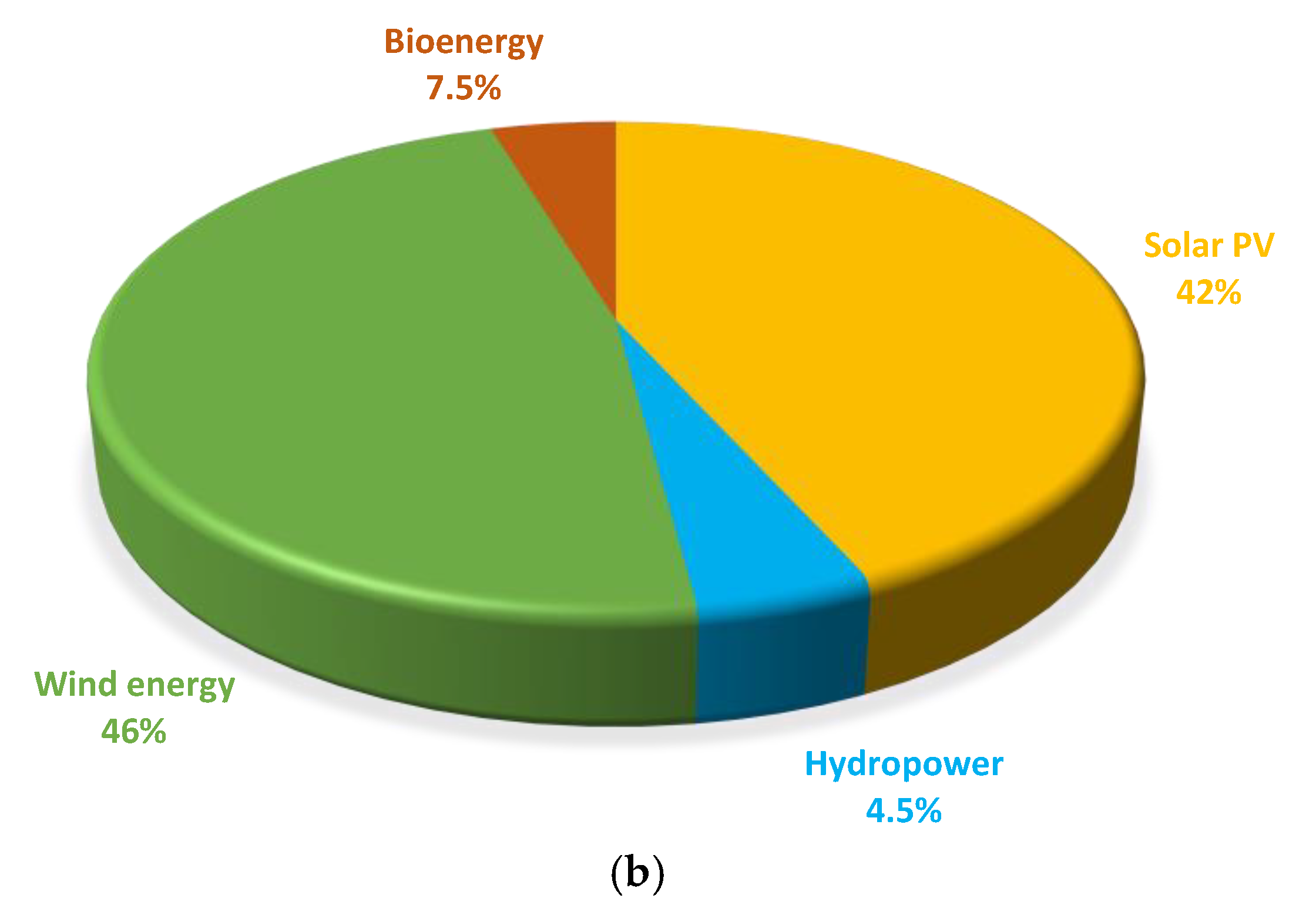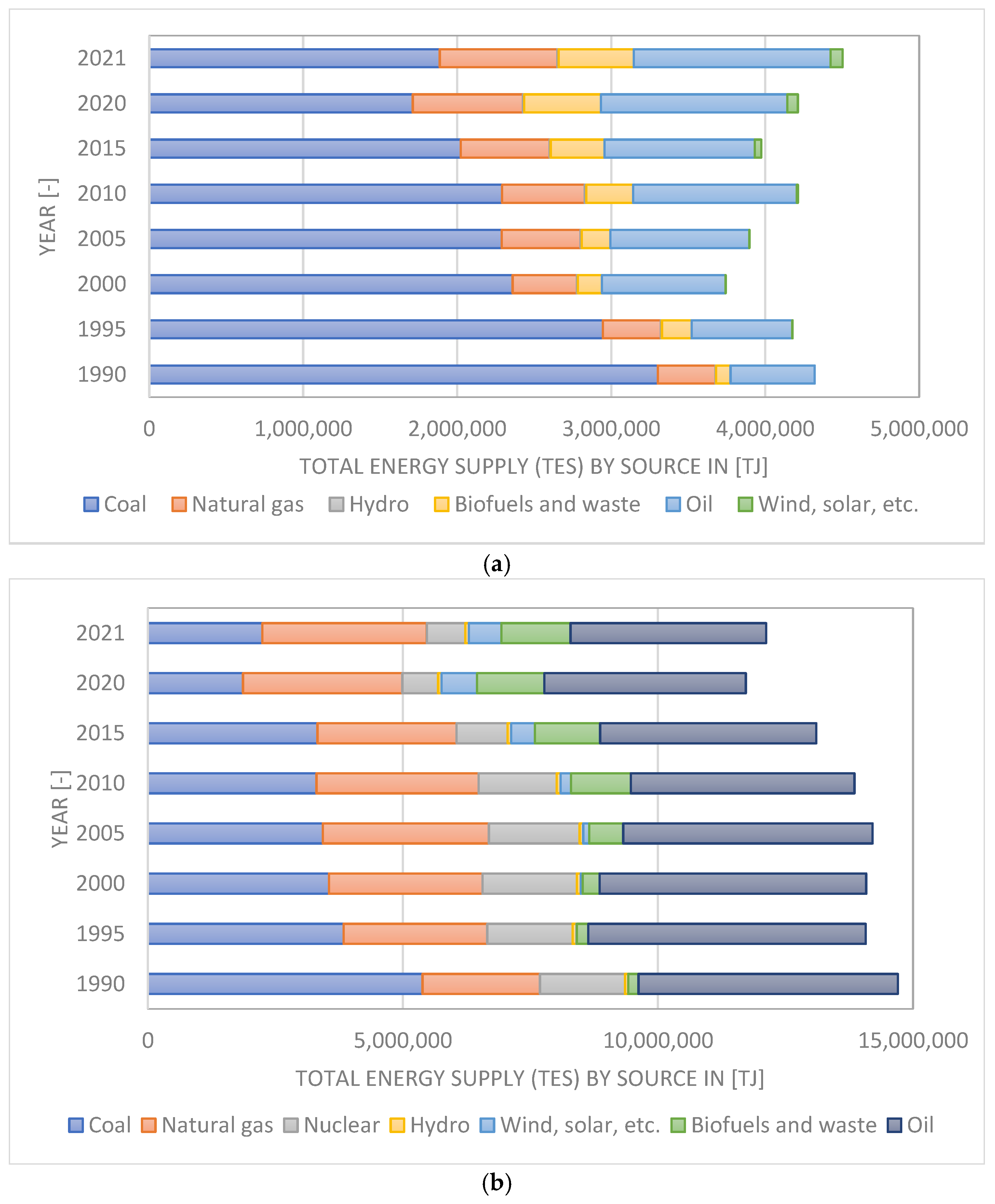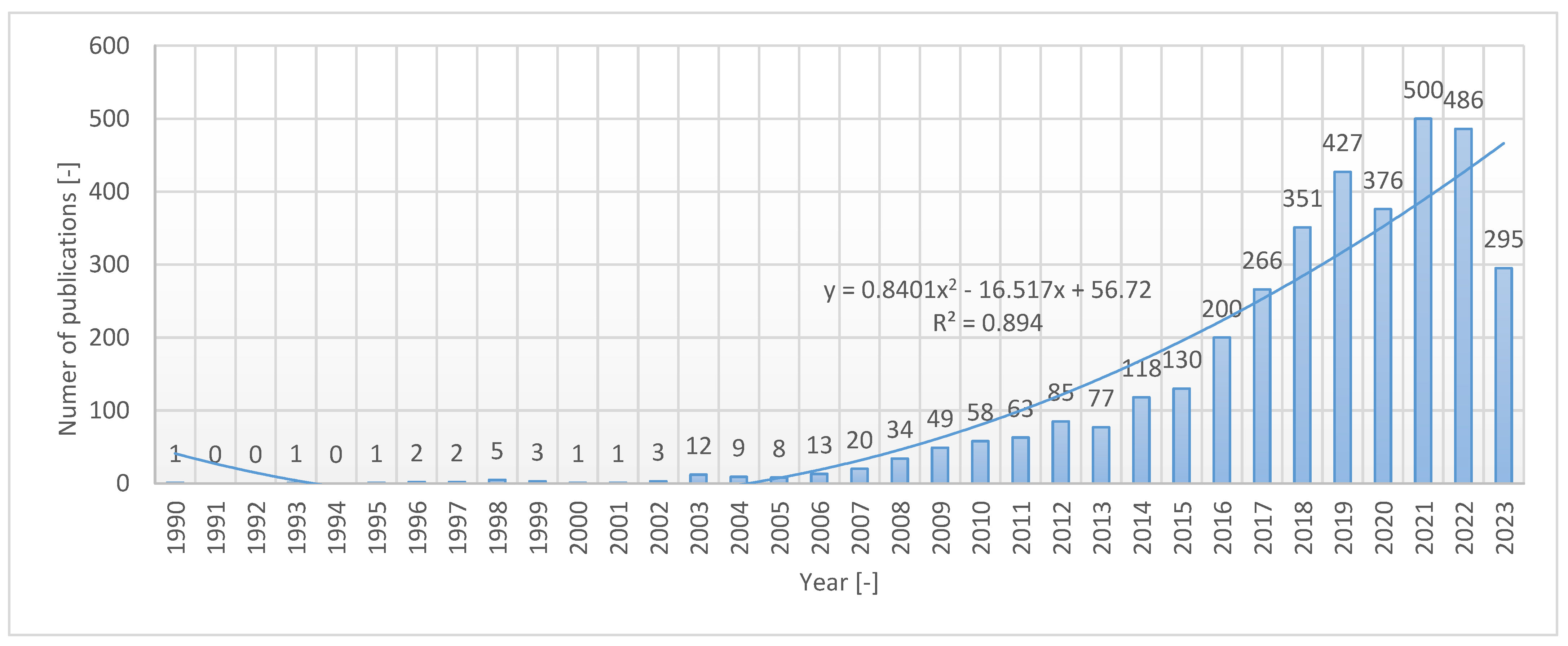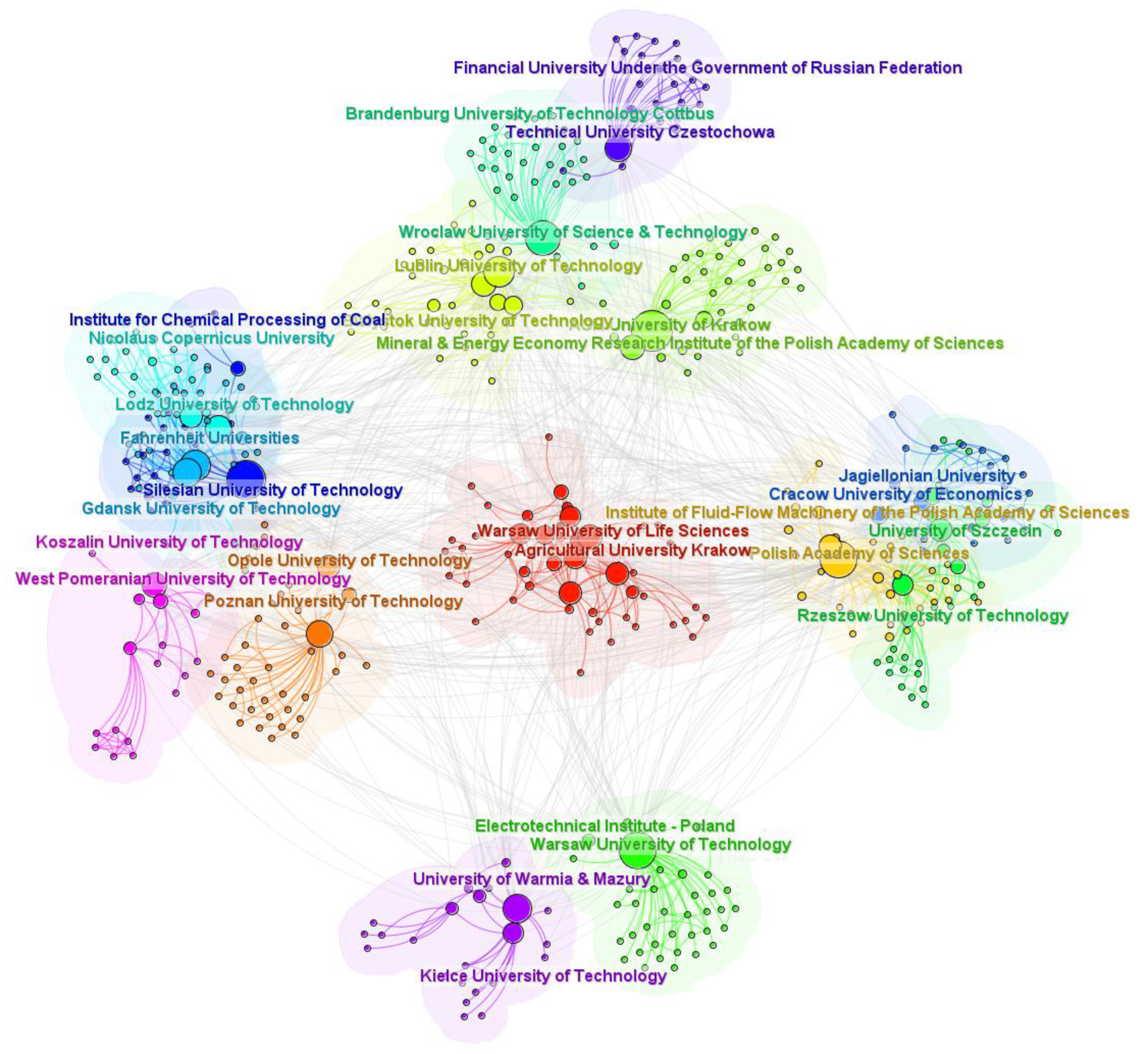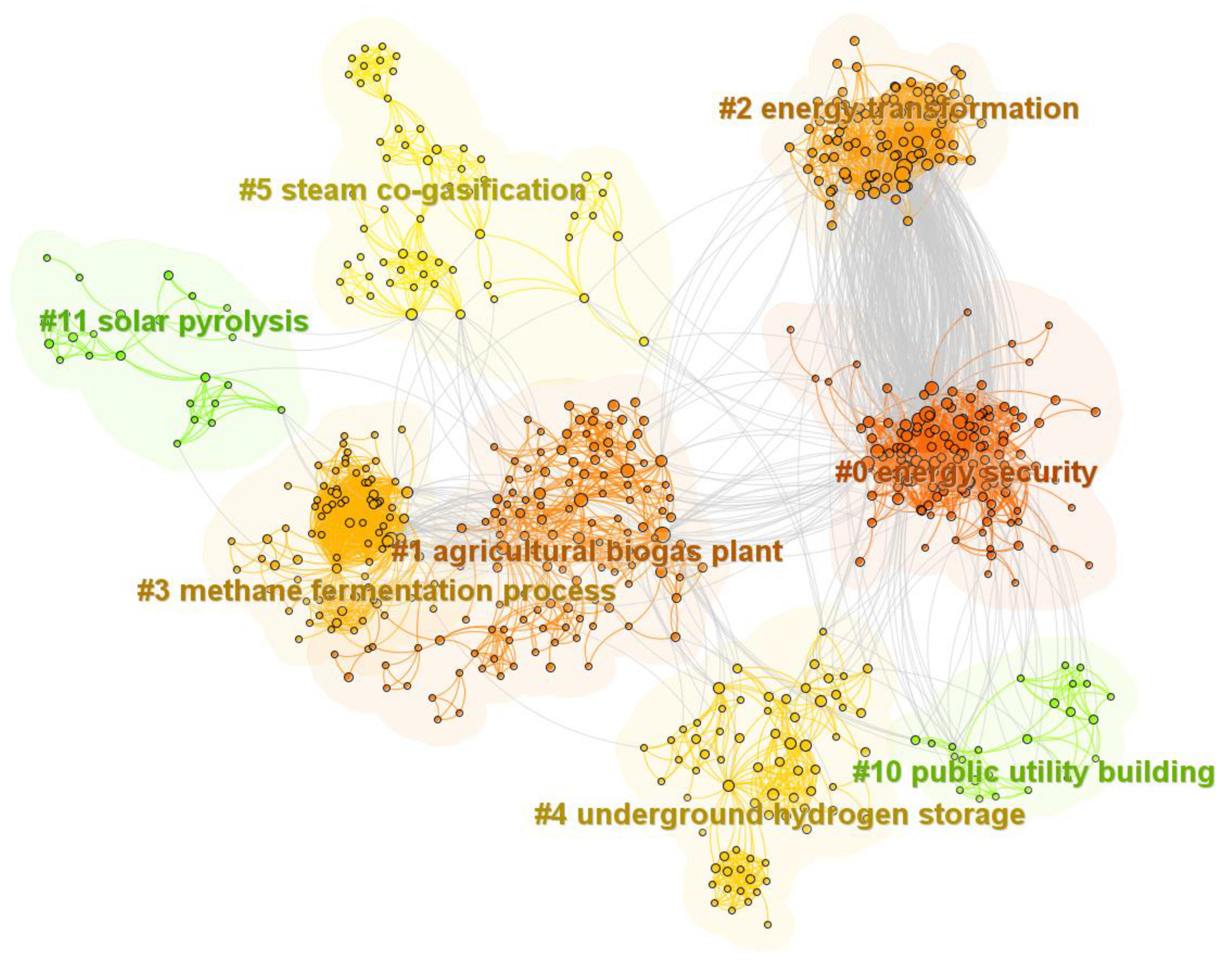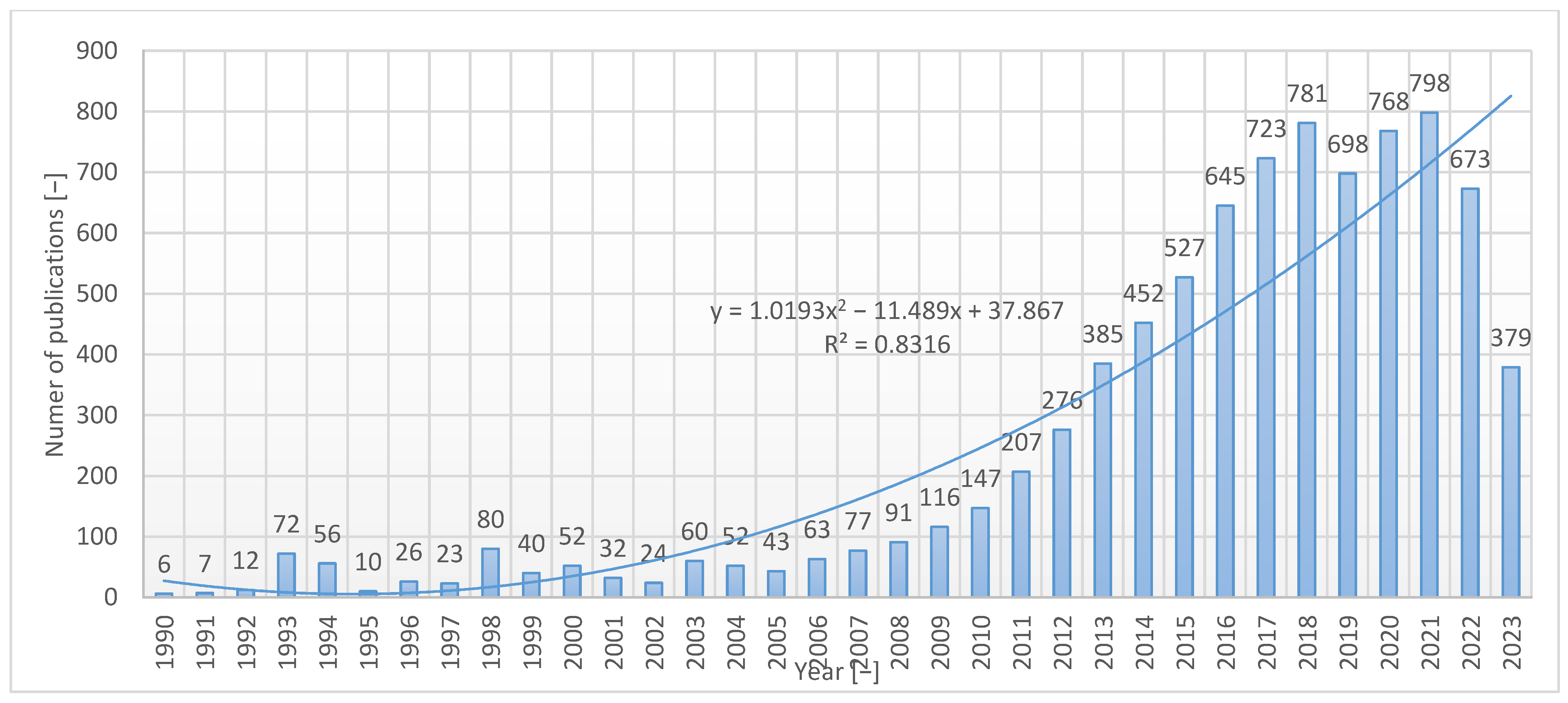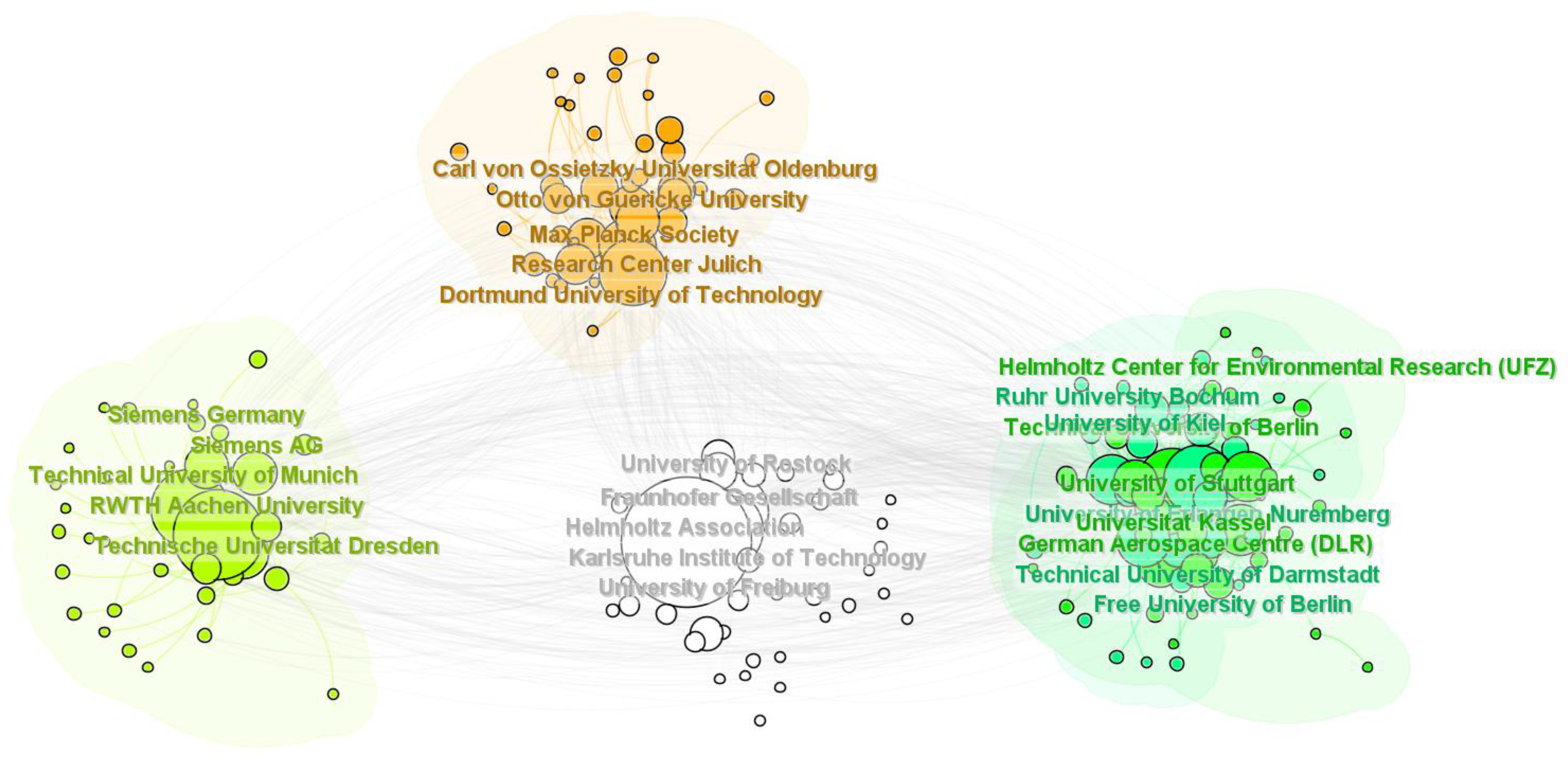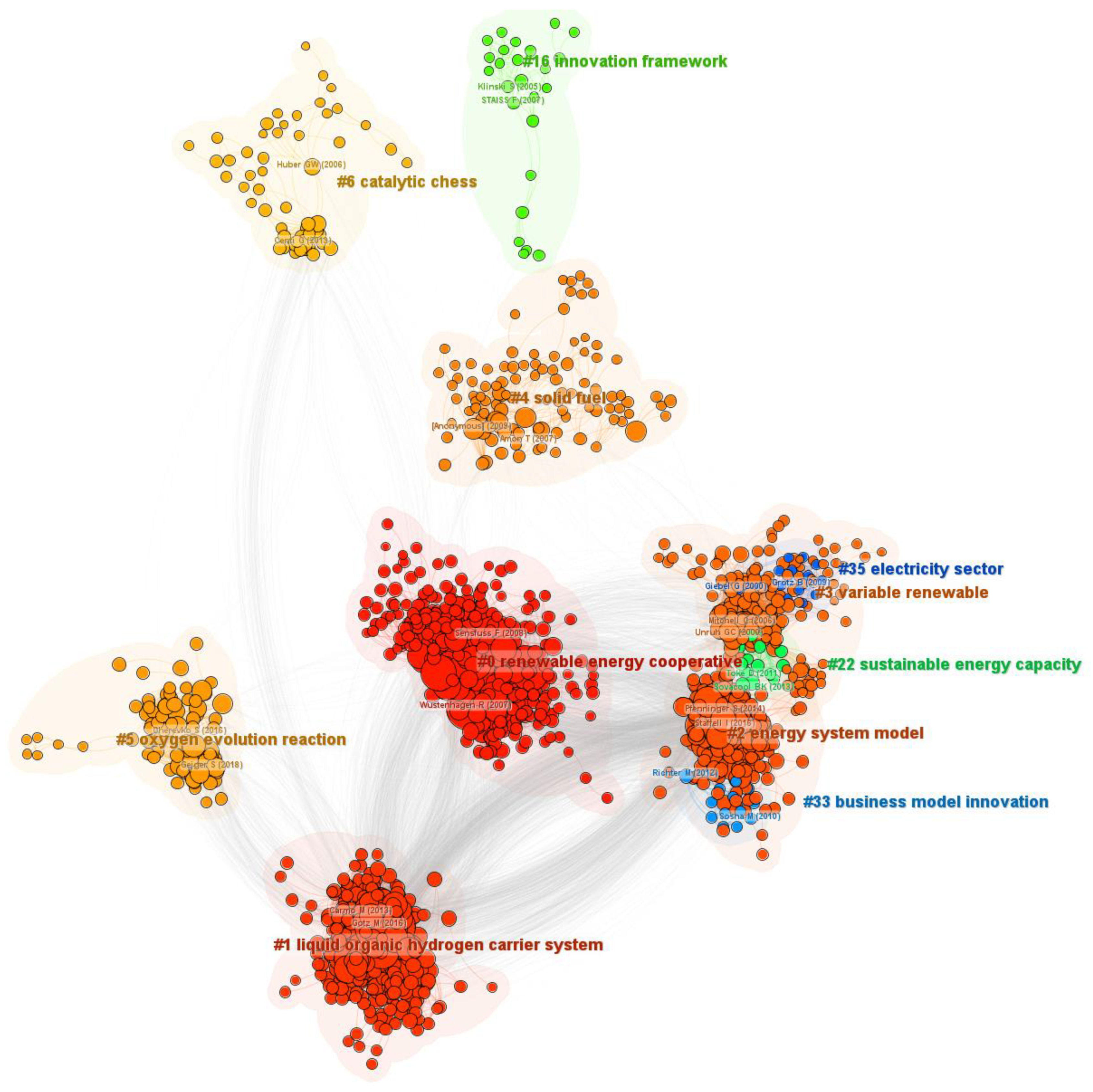1. Introduction
The initiation of renewable energy development stands as a critical imperative for contemporary European society, signifying a concerted effort to address pressing global challenges, including climate change and the imperative shift towards sustainable energy practices. It is essential to recognize that the successful implementation of renewable energy solutions is intricately tied to existing policy frameworks, available infrastructure, and the geographical and climatic nuances of individual regions. Consequently, variations between countries are to be anticipated, reflecting the diverse socio-political, economic, and environmental contexts in which these initiatives unfold.
Over the past few years, there has been a growing recognition among the public about the significant impact of greenhouse gas emissions on the Earth’s climate. This highlights the compelling necessity to reduce our reliance on fossil fuels [
1,
2,
3]. As a result, renewable energy sources have become increasingly central in the energy strategies of numerous nations, with Poland and Germany being no exception [
4,
5]. This transformation reflects a global shift towards more sustainable and environmentally responsible energy practices [
6,
7,
8,
9].
Renewable energy sources, with a particular focus on solar, wind, and hydropower, are steadily and consistently gaining recognition on a global scale as dependable and eco-friendly alternatives to traditional fossil fuels [
10]. This transition signifies a noteworthy advancement in the direction of a more sustainable and ecologically mindful energy landscape. It underscores the global commitment to reducing the environmental footprint associated with energy generation and consumption [
11]. This is in accordance with the energy regulations set forth by the European Union, which require member states to enhance the proportion of renewable energy in their comprehensive energy portfolios [
12]. This directive reflects the EU’s commitment to fostering sustainable and environmentally responsible energy practices across its member nations [
13,
14,
15]. Poland and Germany, both exhibiting comparable energy compositions, are firmly adhering to this prevailing global model by intensifying their investments in renewable energy sources. This concerted effort demonstrates their commitment to sustainability and aligns with global trends in renewable energy development [
16,
17].
Renewable energy is becoming increasingly pivotal in the context of globalized interactions, significantly influencing the way nations collaborate and engage with each other [
18,
19]. As the global community grows more conscious of the need for sustainable development, sources of renewable energy such as solar, wind, hydroelectric, and bioenergy are taking center stage in international trade and diplomacy [
20]. This transformation is largely driven by the pressing need to address climate change and reduce reliance on fossil fuels, catalyzing substantial investments in eco-friendly technologies [
21].
The phenomenon of globalization has been instrumental in spreading renewable energy technologies beyond borders, allowing resource-rich countries to share their expertise and innovative solutions [
22,
23,
24]. This evolution has introduced a novel aspect to global economics, seamlessly integrating energy security and environmental sustainability with domestic and international policy frameworks [
25]. Furthermore, the ascendance of renewable energy is fostering new forms of alliances and partnerships, particularly noticeable among developing countries as they aim to bypass the conventional paths of development dependent on fossil fuels [
26,
27].
Thus, the synergy between renewable energy and globalization is not just transforming energy markets; it is also reshaping geopolitical landscapes. This is paving the way towards a more interconnected and ecologically aware global society [
28,
29].
The transition to renewable energy has varying impacts on social equity across different countries, influenced by factors such as technology, policy, and historical contexts. Generally, the adoption of renewable energy promotes social equity, although the effectiveness of this outcome depends on the specific policies implemented [
30,
31,
32]. Notably, wealthier countries tend to experience more substantial improvements in social equity, underscoring the importance of integrating renewable energy policies with broader human development objectives [
33,
34]. In this context, social equity refers to the equitable distribution of the benefits and costs arising from the development of renewable energy. Renewable energy can be a strategic avenue for improving social equity. Nonetheless, policymakers need to be aware of potential challenges. The most effective policy tools for diverse countries should be identified, ensuring that the shift towards renewable energy is both equitable and efficient [
35,
36].
The global energy paradigm is undergoing a fundamental transformation, with renewable energy sources emerging as pivotal elements in the pursuit of sustainable and environmentally conscientious energy systems. This paradigm shift, catalyzed by the imperative to mitigate climate change and reduce dependency on fossil fuels, is characterized by an accelerated adoption of alternative energy sources, such as photovoltaics (solar), aeolian (wind), hydroelectric, and geothermal technologies. These renewable sources are revolutionizing the energy matrix by providing more ecologically benign alternatives to conventional fossil fuel-based energy generation [
37]. Concurrent advancements in technology and the reduction in associated costs have enhanced the accessibility and economic feasibility of renewable energy solutions, fostering their broader implementation [
38]. This transition transcends the mere substitution of energy sources; it encompasses a holistic metamorphosis encompassing policy reformulation, technological progression, and a shift in societal norms pertaining to energy utilization and environmental conservation [
39]. The efficacious integration of renewable energy sources into extant power grids, complemented by advancements in energy storage mechanisms, represents a critical juncture in the quest for a resilient and sustainable energy future [
40].
Furthermore, the transition towards renewable energy sources serves a dual purpose. It not only addresses the environmental challenges associated with fossil fuels but also enhances energy security by diversifying the energy mix, thus reducing dependence on fossil fuel imports. The inherent intermittency of specific renewable sources, such as wind and solar, has spurred innovation in energy storage technologies and smart grid solutions, ensuring a reliable and consistent energy supply. The collective effort aimed at advancing renewable energy is also creating economic opportunities, promoting job growth, and positioning Germany as leader in the global renewable energy sector. In doing so, it is making significant contributions to energy sustainability objectives and climate change mitigation efforts. The transition towards renewable energy signifies a pivotal transformation in the energy landscape, aligning with international efforts to combat climate change and establish sustainable energy systems. It also underscores the dynamic interplay between environmental, economic, and security considerations in energy policy and practice [
25,
41,
42]. The renewable energy sector in Poland has experienced significant growth due to favorable conditions and financial backing [
43,
44,
45]. However, challenges lie ahead, such as legal modifications, insufficient backing for energy storage, and underdeveloped electrical grids [
46]. Achieving EU objectives and bolstering energy security necessitates the expansion of infrastructure and the implementation of advanced grid technologies [
47,
48,
49]. Policymakers can play a pivotal role by introducing incentives, tax credits, and environmental education initiatives to raise awareness and encourage the adoption of renewable energy sources, with a specific focus on photovoltaics [
50,
51,
52]. These measures effectively address the increasing electricity demand and environmental considerations [
53,
54,
55].
The convergence of renewable energy systems and digitalization is precipitating a significant paradigmatic transition, advancing green competitiveness within the framework of sustainable development, and exerting a multifaceted impact on the labor market [
56,
57]. The ascendancy of renewables such as photovoltaic (solar) and aerodynamic (wind) energy sources is concurrently complemented by digital innovations that are critical in augmenting their operational efficacy and assimilation into existing power grids [
58,
59,
60,
61]. This confluence is instrumental in bolstering green competitiveness across industrial sectors and national economies, thus creating a milieu where eco-efficient practices yield both environmental and economic dividends [
62,
63]. Advanced digital mechanisms, including intelligent grid technologies, artificial intelligence for predictive maintenance, and sophisticated data analytics for energy management, are at the forefront of redefining the utilization, distribution, and consumption paradigms of renewable energy [
64,
65,
66]. These advancements contribute to the diminution of carbon footprints and operational expenditures. The ongoing transition, however, presents labor market challenges, necessitating the acquisition of novel skill sets and catalyzing employment opportunities in nascent green industries, while concurrently disrupting established energy sectors. This dynamic shift towards renewable energy and digitization necessitates a comprehensive strategy in labor force development and educational curricula, aiming to equip the workforce with competencies requisite for a sustainable and digitally advanced economic landscape [
67,
68]. Ultimately, this integrative approach to renewable energy and digital transformation is fundamental in navigating the global economy towards a trajectory of sustainable development, harmonizing environmental stewardship with economic progression and labor market evolution [
69].
The paper undertakes a bibliometric examination of studies associated with renewable energy sources within the contexts of both Poland and Germany. In this comparative analysis, the focus turns to the juxtaposition of Poland and Germany—two nations that share commonalities in terms of climate, wind, and solar conditions, yet diverge significantly in political culture and energy systems, notably the prominence of coal in their respective energy portfolios. This study leverages bibliometric analysis as a robust and objective tool to scrutinize and contrast the research landscapes of Poland and Germany, offering valuable insights into the distinct trajectories and priorities guiding renewable energy research in these nations. Through a meticulous examination of scholarly outputs, this research aims to discern discernible patterns, identify research gaps, and contribute nuanced perspectives that can inform strategic policy decisions, fostering the broader advancement of renewable energy across the European landscape. This extensive investigation is predicated on data sourced from publications documented within the Web of Science database, encompassing a time span from 1990 to 2023. This research aims to provide a comprehensive overview of the academic contributions and trends in the field of renewable energy within the specified regions, shedding light on the evolution of this critical area of study over more than three decades.
The assessment unfolds in two distinct phases. Firstly, it delves into the historical context of renewable energy trends in Poland and Germany through a comparative analysis. Subsequently, the paper proceeds to conduct a bibliometric analysis of renewable energy research.
In
Section 2, the paper elucidates the fundamental aspects of the research’s materials and methodology, providing a comprehensive depiction of the case study under examination.
Advancing to
Section 3, the paper meticulously carries out a bibliometric analysis, offering a thorough examination of the data and presenting the resulting insights.
In
Section 4, a comprehensive synthesis of the bibliometric analysis is presented, encapsulating key findings and insights derived from the research.
2. Materials and Methods
2.1. General Characterisation of the Studied Countries
Poland is situated in Central Europe, between 14°08′ and 24°08′ E and 49°00′ and 54°50′ N. Poland shares its borders with Germany to the west (border length approximately 467 km), the Czech Republic to the south, Slovakia, Ukraine, Belarus, and Lithuania. Germany is located in Central Europe, between 5°52′ and 15°02′ E and 47°17′ and 55°05′ N. Germany shares its borders with France to the west, Austria and Switzerland to the south, Denmark to the north, and the Czech Republic to the east.
The population of Poland exceeds 38 million inhabitants, with a predominance of working-age population. The population density is approximately 122 people per km². Germany has over 83 million inhabitants, with a diverse ethnic population and a population density of around 237 people per km². The GDP per capita in Poland is approximately $22,000 (according to IMF), placing the country at a lower average level compared to other European Union countries. German GDP per capita exceeds $53,000 (according to IMF), indicating a high standard of living and a powerful economy.
Poland has a temperate climate, with average temperatures in January around −1 °C and in July around 18 °C. Germany also has a temperate climate, with average temperatures in January at about 0 °C and in July around 17 °C.
In Poland, favorable conditions exist for onshore wind farms, particularly in the northern and western regions. In addition, coastal areas near the Baltic Sea and elevated terrains contribute to varied wind speeds. Germany benefits from consistent and strong wind resources, especially in coastal and elevated areas. Offshore wind farms in the North and Baltic Seas take advantage of abundant wind conditions. Poland averages moderate solar irradiance, with sun-rich areas in the southern regions. Solar projects need to consider land use, especially in agricultural areas. Germany, with moderate solar irradiance, has widespread rooftop solar installations and solar farms. The rivers and topography of Poland offer opportunities for both large-scale and small-scale hydropower projects. Modernization efforts focusing on hydropower facilities in Germany aim to improve efficiency while minimizing environmental impact.
In the early 2000s, Poland was in the early stages of formulating its approach to renewable energy, primarily relying on traditional sources, notably coal. Recognizing the necessity to transition towards a more sustainable energy framework, Poland underwent a significant policy shift. In subsequent years, the nation adopted a proactive stance by enacting tailored legal frameworks designed to enhance the proportion of renewable energy. These legislative measures, inclusive of dedicated laws for renewable energy, played a pivotal role in stimulating the growth and advancement of the sector. In alignment with this evolving commitment, Poland experienced a notable upswing in investments directed at renewable energy projects. Notably, these investments were channeled into the establishment of wind farms and photovoltaic installations, illustrating a strategic pivot towards diversifying the energy portfolio and adopting cleaner, environmentally friendly alternatives. This trajectory underscores Poland’s progressive energy policies and its ongoing journey to incorporate renewable sources into its energy landscape [
70,
71,
72].
Germany’s dedication to a sustainable energy trajectory is exemplified through its enduring commitment to the Energiewende policy, an innovative initiative launched in the 1990s. This policy embodies a holistic approach to energy transition, with a primary focus on augmenting the proportion of renewable sources within the energy landscape. Integral to this transition is Germany’s active advocacy of the decentralization of energy production. Underlining the significance of localized energy generation, the nation actively endorses initiatives such as citizen energy cooperatives [
73,
74]. This decentralization strategy aligns with the overarching objective of cultivating community engagement and empowering citizens to actively contribute to the shift towards cleaner energy sources. In tandem with these endeavors, Germany has exhibited a robust commitment to bolstering the renewable energy sector through substantial financial support [
75,
76,
77,
78]. The state’s provision of generous financial backing, encompassing premium systems and subsidies, has played a pivotal role in expediting the advancement of critical renewable technologies [
79,
80,
81]. This proactive approach has notably hastened the proliferation of photovoltaic installations, wind farms, and various other renewable energy sources, substantiating Germany’s prominent global standing in the adoption of renewable energy.
2.2. Background of Renewable Energy Trends in Poland and Germany—Comparative Analysis
Figure 1 provides a visual representation of the progression of renewable energy’s proportion within the energy compositions of both Poland and Germany, spanning the years 2004 to 2021. This data, sourced from Eurostat, facilitates a comprehensive analysis of the historical trends and developments in the utilization of renewable energy in these nations.
It is evident that Poland and Germany share a comparable trajectory of growth in the installed capacity of renewable energy sources. In 2021, Poland’s renewable energy sources accounted for 15.6% of its total energy mix, whereas Germany’s proportion was slightly higher at 19.6%. Notably, in the previous year, both countries effectively achieved the European Union’s stipulated targets, with Poland reaching 15% and Germany attaining 18% in terms of the contribution of renewable energy sources to their energy profiles.
For a more detailed representation of the distribution of different renewable energy sources in Poland and Germany, please refer to
Figure 2.
These data underscore the concerted efforts of both nations to enhance the role of renewable energy sources within their energy landscapes, as they align with EU sustainability objectives. The gradual progression toward higher proportions of renewables reflects a pivotal shift in energy policies, promoting the transition to more sustainable and environmentally friendly methods of energy production.
Poland and Germany exhibit a striking similarity in the distribution of individual energy sources within their respective energy mixes, as illustrated in
Figure 2. Notably, photovoltaics holds a dominant position in Poland, accounting for 54% of the overall installed capacity in renewable energy sources. In contrast, Germany’s primary source of renewable energy is wind power, encompassing both onshore and offshore power plants, and it constitutes 46% of their total installed capacity. Further details regarding the installed capacity of each renewable energy source in 2022 are presented in
Table 1.
This observation underscores the shared reliance on renewable energy sources in these two countries while highlighting the distinct preferences and strengths within their renewable energy sectors. The juxtaposition of photovoltaics in Poland and wind power in Germany is an intriguing facet of their renewable energy landscapes, indicative of diverse strategies and priorities in the pursuit of sustainable energy generation.
When assessing the capacity installed in renewable energy sources, it is crucial to take into account the overall capacity installed of all power facilities. In Poland, the total installed capacity stands at approximately 60 GW, whereas in Germany it is around 250 GW. Consequently, the overall installed capacity of renewable energy sources in Poland constitutes approximately 37% of the overall installed capacity, while in Germany it comprises 55%. Nonetheless, it is imperative to acknowledge that energy harnessed from renewable sources, including photovoltaic systems and wind power, displays notable variability and is significantly contingent upon prevailing weather conditions. In contrast, hydroelectric power plants typically operate as peaking power facilities, primarily engaged during periods of heightened energy demand. Consequently, the actual energy yield from renewable sources often falls below the anticipated potential suggested by the installed capacity. This discrepancy underscores the intricate relationship between renewable energy sources and environmental factors, as well as the role of hydroelectric power in meeting peak energy requirements [
83,
84,
85,
86].
The structure of total energy supply by source in Poland and Germany, based on data sourced from International Energy Agency, is presented in
Figure 3.
The provided data outlines the energy consumption profiles of Poland and Germany over the years, measured in terajoules (TJ). In 1990, Poland’s energy landscape was characterized by a heavy reliance on coal, which accounted for a significant portion of the total energy consumption at 3,302,214 TJ. Over the subsequent decades, there was a discernible shift towards renewable energy sources, with wind, solar, and hydro showing substantial increases by 2021. Meanwhile, Germany’s energy consumption in 1990 featured a more diversified mix, including significant contributions from coal, natural gas, nuclear, and oil. Over the years, Germany demonstrated a considerable transition towards renewable energy, with wind, solar, and biofuels gaining prominence, particularly after 2005. It should be noted, that Germany is a global frontrunner in both offshore wind energy and solar photovoltaic technology, showcasing proficiency in biogas as well. The nation is actively engaged in the advancement of smart grids, aimed at efficiently managing the increasing volume of renewable energy to enhance overall system efficiency and reliability. Germany’s unwavering commitment to investing in and innovating in renewable energy substantiates its position as a global leader. The country’s all-encompassing strategy includes expertise in offshore wind farms, cutting-edge energy storage solutions, and the implementation of smart grid technologies. Both countries reflect a global trend of moving away from traditional fossil fuels and embracing more sustainable and environmentally friendly energy sources to address climate change concerns. Despite a general global trend toward reducing coal dependence for environmental reasons, Poland continued to exhibit a substantial dependency on coal throughout the relevant years. This stark contrast underscores the challenges and variations in energy transition strategies among different countries, highlighting Poland’s ongoing struggle to diversify its energy mix away from coal
2.3. Exploring Distinct Trajectories: Hypotheses for Comparative Analysis of Renewable Energy Research in Poland and Germany
Thanks to the energy transformation initiated in the 1990s, Germany has emerged as one of the European leaders in renewable energy. Despite a substantial increase in installed capacity in Renewable Energy Sources (RES), Poland continues to rely on non-renewable sources, such as hard coal, brown coal, and natural gas, for its energy. This presents a significant challenge to the energy transformation in the country. Leveraging Germany’s experiences in conducting energy transformation, shared on the international stage, countries like Poland can learn from these experiences and adapt them to their own conditions. This adaptation has the potential to expedite global efforts toward sustainable energy.
In the context of the global imperative to transition towards sustainable energy sources, the role of renewable energy in mitigating climate change and ensuring a secure energy future has become increasingly pivotal. As European nations actively contribute to this paradigm shift, the importance of understanding and advancing renewable energy research cannot be overstated. This study embarks on a comprehensive analysis of renewable energy research in two European countries, namely Poland and Germany. The research is grounded in the recognition that, despite similarities in climate conditions, the energy landscapes of these countries differ significantly, reflecting diverse political cultures and energy system compositions. The overarching goal is to unravel the distinct patterns, collaborative dynamics, and influencing factors that shape renewable energy research in Poland and Germany. To guide this exploration, we formulate three key research questions, each designed to provide nuanced insights into the multifaceted aspects of renewable energy studies within these nations:
“What are the major thematic areas within renewable energy research that have garnered the highest attention in Poland and Germany over the past three decades?”
“What factors contribute to the observed differences in the outcomes of the bibliometric analysis of renewable energy research in Poland and Germany over the past three decades?”
“How does the identification of key topics and trends in the field of renewable energy sources contribute to our understanding of the direction in which science and technology in RES are developing?”
Additionally, hypotheses are posited to offer testable propositions that will guide the empirical analysis and contribute to a deeper understanding of the unique trajectories of renewable energy research in Poland and Germany. Through this investigation, we aim to contribute valuable knowledge to inform policy decisions, foster collaboration, and further the advancement of renewable energy initiatives in the European context.
2.4. Literature Review Using Bibliometric Methods
Bibliometric analysis is a research approach that relies on statistical methods to collect, process, and analyze bibliographic data from scientific publications [
88,
89,
90,
91]. Its primary goal is to evaluate the influence of these publications on the advancement of a particular scientific domain and to recognize pivotal authors, journals, subjects, and research institutions.
For this analysis, the CiteSpace 6.2.R6 Advanced was utilized, facilitating the examination of publications and citations while generating visual representations that depict the interrelationships among publications, authors, institutions, and keywords [
92,
93,
94]. CiteSpace enables the creation of maps and charts illustrating connections among scientific publications in a specific research field. Additionally, the software can discern trends and patterns in the scientific literature, identifying influential authors, institutions, research topics, and academic journals. It is noteworthy that CiteSpace is adaptable for analyzing bibliometric data from diverse sources, including databases such as Web of Science, Scopus, PubMed, and others.
In this study, data was retrieved from the Web of Science database using the search term “Renewable energy.” Filters were then applied, selecting the country Poland or Germany. Then, an affiliation filter was used to select universities and institutes from a given country, which allowed for a more detailed examination of renewable energy research trends in these two countries.
3. Bibliometric Analysis and Results
3.1. Bibliometric Analysis Focused on Poland
Figure 4 shows the number of publications in which the authors indicated universities from Poland as affiliations in particular years. The total number of publications for bibliometric analysis is 3597.
Figure 5 illustrates the assessment of publications based on author affiliation. This analysis enables the identification of the institutes or universities that are particularly engaged in research on renewable energy.
Individual thematically related groups have been marked with different colors. The size of a given node is related to the number of publications from a given university, while connections between individual countries (gray lines) indicate mutual citations. Based on the above diagram of cooperation between institutions,
Table 2 presents 10 universities with the highest centrality index. The centrality index identifies a node that connects two or more large groups. This allows identification of key nodes in the network. This means that the node with the highest centrality index is a key node in research, characterized by innovation and frequent citation by other scientists.
The analysis distinctly reveals that the AGH University of Science and Technology in Krakow is at the forefront in terms of the number of published scientific works related to renewable energy, in accordance with the established criteria. However, in the context of the centrality index, demonstrating a significant role in the realm of research concerning renewable energy sources, the Polish Academy of Sciences and the Wrocław University of Science and Technology are the institutions whose research enjoys the greatest recognition, which means that the scientific works of their scientists are most often cited in the scientific literature regarding this thematic area.
Figure 6 presents an examination of citations categorized by primary areas of interest for researchers. Analyzing the graph, it can be concluded that the largest node is the node called “energy security”. This node includes 139 articles. The second largest node is “agricultural biogas plant” with 127 articles, and the third is “energy transformation”. It can be said that the greatest interest of scientists in Poland is the topic of energy security and the energy transformation of Poland, in which most of the energy is produced in coal-fired power plants. This is evidenced by the largest number of connections between these nodes. As presented in the
Section 2, the need to restructure the coal sector and enhance the proportion of energy derived from renewable sources pose challenges for the Polish energy industry and power grids, which are not adapted to distributed energy based on small energy sources. An additional threat may be problems with the maintenance stability of energy supplies and ensuring energy security in the course of the energy transformation process.
Utilizing the analysis depicted in
Figure 5, CiteSpace conducts an examination of publications using the citation burst indicator. This indicator proves valuable in identifying articles that have garnered a noteworthy number of citations within a relatively brief timeframe. A sustained sequence of citations can be employed to recognize articles of scientific significance and those that have exerted a substantial impact on an evolving field.
Figure 7 showcases the top five publications exhibiting the most significant bursts of citations. It is an important tool in scientific research, enabling the identification of influential and valuable works that influenced the shaping of a given area of knowledge.
The primary article concentrates on the progress of renewable energy sources in Poland and the European Union [
95]. The authors analyze the measures implemented to develop renewable energy sources, the present condition and the future outlook regarding the utilization of renewable sources in Poland and the European Union. The second article analyzes the transformation of the Polish economy, historically associated with coal, into an economy employing low-emission technologies, with particular emphasis on rural areas [
96]. The authors present the potential for decreasing pollutant emissions in rural regions by developing renewable energy sources, such as biogas plants, wind and photovoltaic power plants. The article highlights the role of renewable energy in the sustainable development of rural areas in Poland. The third article focuses on the analysis of the technical and economic characteristics of this accelerated energy transformation by 2030 [
97]. The research suggests that pivotal components include energy efficiency and technologies related to renewable energy of this transformation, and their synergy is equally important. The article highlights the favorable economic aspects, resource availability, technology scalability, and socio-economic benefits resulting from such a transformation. The significance of incorporating biogas energy into Poland’s energy composition is underscored in the fourth article [
98]. The authors assess the significance of renewable energy in the nation and scrutinize public sentiments regarding the utilization and advancement of unconventional energy. The publication also deliberates on the merits and demerits of various forms of renewable energy sources, in addition to addressing impediments impeding the progress of green energy in Poland. It puts forth recommendations to boost the proportion of biogas energy in the overall energy composition. The fifth article discusses the functioning of the renewable energy sector in Poland and its importance in the context of energy changes in the country’s economy, influencing the advancement of innovative technologies, competitiveness and innovation. Researchers analyzed the possibilities of improving this sector, taking into account social and economic aspects, conducting a critical assessment of its situation and an expert survey [
71]. The authors demonstrated the need to simplify the applicable legal regulations in Poland, drawing attention to the potential for the development of solar, wind and biomass energy and the need to educate society in the use of renewable energy and its positive impact on a low-emission economy, job creation and reduction of harmful substances emissions into the environment.
3.2. Bibliometric Analysis for Germany
Figure 8 shows the number of publications in which the authors indicated universities from Germany as affiliations in particular years. The total number of publications for bibliometric analysis is 8401 for the “renewable energy” search term.
Figure 9 shows the analysis of cooperation between universities in Germany.
Table 3 presents the top 10 institutes along with their respective centrality coefficients, showcasing the institutions with the highest volume of publications in renewable energy sources. The analysis indicates that researchers affiliated with the Helmholtz Association contribute the largest number of publications. The centrality coefficient suggests that the Helmholtz Association not only accumulates the highest number of citations but also exerts the most substantial influence on other scientists. A low centrality index may indicate different specializations of individual research institutions, which may lead to lower coverage of the interests of scientists in individual institutions and, therefore, to a smaller number of mutual citations.
Figure 10 illustrates an examination of citations categorized by primary areas of interest for researchers within the field of renewable energy.
Analyzing the above graph, it can be concluded that the largest node is the “renewable energy cooperative” node, which includes 432 articles.
A renewable energy cooperative, commonly referred to as an RE co-op or REC, is a decentralized, non-governmental endeavor led by local communities and individuals. Its primary objective is to encourage the generation and utilization of renewable energy. Comprising community members united by a shared, enduring vision of a sustainable energy future, the cooperative actively participates in the shift towards renewable energy sources through citizen involvement.
In this way, citizens become “prosumers”, producers and consumers, seeking to democratize energy supplies by reducing their dependence on large corporations. The second large node is the “liquid organic hydrogen carrier system”, which includes 362 items. Liquid Organic Hydrogen Carriers (LOHC) are organic chemicals that can absorb and release hydrogen through chemical reactions. LOHCs can therefore serve as hydrogen storage media. The third largest node is the “energy system model” with 210 articles, which includes articles dealing with modeling the energy system with renewable energy sources.
Figure 11 displays the top five publications experiencing the most substantial citation bursts.
The first article concerns the integration of photovoltaic (PV) electricity into European energy networks [
99]. The authors describe how to use meteorological and satellite data to simulate PV energy production over time. The study focuses on the impact of the increasing number of PV installations on energy demand and the adequacy of the energy system in various European countries. Connecting this to the current situation in Germany, the country’s continued expansion of solar installations aligns with the global trend towards integrating PV into energy networks, as presented in
Figure 3b. The second article focuses on the Power-to-Gas (PtG) process, which might assume a pivotal role in the prospective energy system [
100]. The authors compare available electrolysis and methanation technologies in terms of their effectiveness, costs and flexibility. The article analyzes various water electrolysis technologies and reactors for the methanation process. It also explores the economic facets and efficiency of Power-to-Gas (PtG). This article, relevant to Germany’s energy landscape, aligns with the country’s emphasis on technological advancements in PtG processes, reflecting its commitment to sustainable energy solutions. The third article examines the impact of support for electricity production from renewable energy sources in Germany on the energy market [
101]. The authors analyze the impact of renewable energy production on prices in the electricity market. The study shows that renewable energy production lowers prices, which benefits consumers. This aligns with Germany’s ongoing efforts to support and incentivize renewable energy production, contributing to its position as a leader in the global energy transition. The fourth article focuses on the need to store electricity in the form of gas to compensate for unstable renewable energy production [
102]. The authors discuss various Power-to-Gas (PtG) processes and analyze their usefulness and economic aspects. Considering Germany’s increased reliance on renewable energy, the exploration of effective storage solutions becomes particularly relevant in managing the intermittency of renewable sources. The fifth article explores the future of water electrolysis technology in the context of converting renewable energy into storage gas [
103]. The authors conduct expert studies to assess the capital costs, durability and effectiveness of three electrolysis technologies. The study shows that there is potential for cost reduction and highlights the importance of innovation and research in the field of water electrolysis. This resonates with Germany’s commitment to advancing electrolysis technology for storing renewable energy, aligning with its goals for a sustainable energy future.
A shared theme among these articles is the keen focus on advancing research and technology development related to renewable energy sources. These works also delve into the profound effects of such technologies on energy markets and society, in addition to exploring innovative strategies for efficiently storing electricity and converting it into longer-lasting forms. This collective body of research significantly contributes to an enhanced comprehension and utilization of renewable energy, with the potential to exert a substantial influence on the trajectory of energy in Germany and globally, as presented in
Section 3.2. It forms a critical building block for a more sustainable and environmentally responsible future in the realm of energy.
3.3. Comparative Bibliometric Analysis
Poland and Germany both actively contribute to renewable energy research, but the scale of their research output varies significantly. Poland, as depicted in
Figure 4, accounts for 3597 publications. In contrast,
Figure 8 highlights a more extensive research landscape in Germany, with 8401 publications, signifying a broader and more diversified research base.
Poland’s research landscape is characterized by the strong presence of the AGH University of Science and Technology in Krakow in terms of publication output. However, when considering centrality, Polish Academy of Sciences and Wrocław University of Science and Technology emerge as prominent institutions. These institutions are recognized for their research quality and frequent citations in the field, indicating their influential role in the research community. Germany, on the other hand, is notably influenced by the Helmholtz Association, which not only publishes a significant number of papers but also holds a substantial centrality coefficient. This high centrality coefficient suggests that the Helmholtz Association has a profound influence on other researchers and plays a central role in shaping the direction of renewable energy research in Germany.
Poland’s research interests are centered around “energy security”, “agricultural biogas plants”, and “energy transformation.” These areas of focus align with the nation’s imperative need to transition from coal-based energy sources and tackle energy security concerns. The emphasis on energy transformation underscores the challenges posed by Poland’s heavy reliance on coal-fired power plants. In contrast, Germany’s research priorities include “renewable energy cooperatives”, “liquid organic hydrogen carrier systems”, and “energy system models.” This signifies a focus on innovative community-driven renewable energy solutions and advanced technologies, including the exploration of novel hydrogen storage systems. It reflects Germany’s commitment to sustainable, community-oriented energy solutions.
In Poland, influential publications address topics such as the development of renewable energy sources in Poland and the European Union, the transition from coal to low-emission technologies, and the analysis of accelerated energy transformation by 2030. These publications highlight the multifaceted aspects of renewable energy, encompassing economic, technological, and social dimensions. German research emphasizes publications related to the integration of photovoltaic electricity into European energy networks, Power-to-Gas (PtG) processes, the impact of renewable energy on electricity prices, and advancements in water electrolysis technology. These publications underscore Germany’s focus on cutting-edge technologies, energy market dynamics, and effective energy storage solutions.
As presented in
Section 3.2, Poland and Germany contribute actively to renewable energy research, but Germany stands out with a more extensive and diverse research landscape, and a focus on cutting-edge technology and innovative community-driven solutions. Poland’s research is primarily geared towards addressing its specific challenges related to transitioning from coal-based energy sources. This comparison underscores the distinct research priorities and emphases in renewable energy research in these two European nations.
Nevertheless, it is noteworthy that Poland is actively progressing in the development of renewable energy sources, albeit at a pace that may be deemed more deliberate in comparison to Germany. Poland has pledged to augment the proportion of renewable energy in its energy portfolio, potentially instigating transformations in the future. Anticipations include increased investments in renewable energy sources within Poland, driven by advancements in technology and evolving societal awareness.
4. Conclusions and Perspectives
Bibliometric analysis is a valuable tool in scientific research, providing a comprehensive means to understand and evaluate the progress of research within the realm of renewable energy resources. By delving into the content of research articles and examining their temporal distribution, researchers can uncover significant trends and chart the course for the advancement of this pivotal domain. In this article, we undertake an analysis of research pertaining to renewable energy sources in both Poland and Germany, leveraging data sourced from the Web of Science database. This research encompasses the identification of key bibliometric indicators, including the volume of publications, citation trends, and the most influential authors and institutions. The examination of these indicators offers enhanced insights into the role of renewable energy sources in the landscape of scientific research.
In Poland, researchers dedicate their efforts to a multifaceted exploration of renewable energy sources, with a pronounced emphasis on concerns related to energy security and the imperative for energy transition. The prevailing prevalence of coal-fired power plants within Poland renders this transformation a formidable challenge, underscored by its compelling urgency. Investigating topics such as energy security and energy transformation is of paramount importance due to Poland’s heavy reliance on coal for energy generation. Effecting change in this context necessitates substantial and foundational overhauls within the energy sector.
Moreover, research in Poland encompasses the investigation of diverse renewable energy technologies, encompassing solar, wind, and hydropower, as viable alternatives to coal. This exploration not only addresses the environmental concerns associated with fossil fuels but also aligns with the global shift toward sustainable and clean energy sources. The multifaceted approach taken by Polish researchers encompasses technical, economic, and policy aspects, aiming to provide comprehensive insights and solutions for the country’s energy challenges.
In the endeavor to diversify the energy mix and reduce reliance on coal, researchers in Poland collaborate with international partners, share knowledge, and actively participate in global efforts to combat climate change. By focusing on renewable energy research, Poland is poised to navigate the complex and interrelated issues of energy security, environmental sustainability, and economic development, making a meaningful contribution to a more sustainable and environmentally responsible energy landscape.
It is noteworthy that, in Poland, researchers demonstrate a comprehensive interest in a wide array of renewable energy sources while diligently examining their respective merits and demerits. Additionally, they rigorously investigate the obstacles hindering the advancement of green energy and proactively put forth recommendations and strategies to augment the proportion of renewable energy sources within the overarching energy portfolio. This research is particularly significant in light of the enduring objectives of reducing greenhouse gas emissions and alleviating the effects of climate change.
In Germany, a considerable body of research is dedicated to the concept of “renewable energy cooperatives”, reflecting the increasing engagement of local communities and individual citizens in both generation and renewable energy consumption. This noteworthy trend in development aspires to democratize the energy supply chain and align it with more inclusive and participatory principles.
Furthermore, German researchers place a significant focus on investigating the repercussions of renewable energy production on the energy market and energy pricing. The outcomes of these studies consistently indicate that the production of renewable energy has the potential to reduce electricity costs, delivering tangible benefits to consumers.
Research activities also extend to the examination of Power-to-Gas (PtG) technology and water electrolysis as methods for electricity storage, unveiling their substantial promise in the realm of renewable energy advancement. Additionally, research concerning hydrogen technology signifies the remarkable progress in this field, hinting at its potential influence on the evolution of electromobility and the feasibility of energy production through fuel cells. These avenues of study underscore Germany’s proactive stance in shaping a sustainable energy landscape and exploring innovative solutions within the renewable energy sector.
The research subjects explored in both Poland and Germany hold substantial significance within the global context of challenges associated with climate change and the imperative to curtail greenhouse gas emissions. Investigations into renewable energy sources represent a pivotal contribution to the establishment of sustainable energy systems underpinned by green technologies.
The distinctions brought to light through this meticulous bibliometric analysis, juxtaposing the research landscapes of Germany and Poland, find their roots in a complex interplay of country-specific factors intrinsic to each region. These variations offer not only a panoramic view of the current status of renewable energy research in both countries but also serve as invaluable signposts for projecting future trajectories. Delving into the intricacies of research themes, publication trends, and collaborative networks allows for a nuanced understanding of the distinctive paths shaping the renewable energy domain in Germany and Poland. This granular comprehension becomes instrumental for stakeholders, researchers, and policymakers alike, as it furnishes nuanced insights into the determinants steering research priorities and the evolutionary dynamics of renewable energy initiatives in each nation. Through the identification of publications with the highest citation rates and the most frequently employed keywords, policymakers and practitioners can enhance their comprehension of the pivotal concepts and methodologies within this domain. This insight equips them to judiciously integrate this information into their endeavors, contributing to informed decision-making and effective implementation in their respective roles. It facilitates a comprehension of the research terrain, enabling the discernment of existing gaps and the recognition of prospects for additional research endeavors. By extrapolating from the present bibliometric insights, a foundation is laid for constructing well-informed projections regarding the forthcoming direction of renewable energy research. This foresight facilitates the formulation of proactive and targeted strategies, tailored to foster sustainable energy development in Germany and Poland. In essence, the bibliometric analysis emerges as a dynamic instrument, not merely enriching our understanding of the contemporary landscape but providing a discerning lens to anticipate and actively shape the future trajectory of renewable energy trends in both countries.


